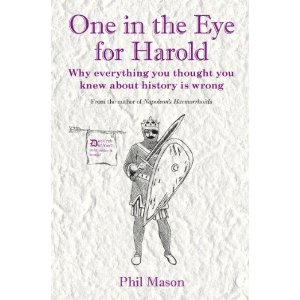One in the Eye for Harold: Why everything you thought you knew about history is wrong
 Phil Mason’s book is stuffed full of bite-sized chunks of myth busting, covering the sorts of topics even people not really interested in history are likely to have heard of, such as how Harold didn’t actually get shot in the eye with an arrow at Hastings and how there was a very important but forgotten subsequent battle.
Phil Mason’s book is stuffed full of bite-sized chunks of myth busting, covering the sorts of topics even people not really interested in history are likely to have heard of, such as how Harold didn’t actually get shot in the eye with an arrow at Hastings and how there was a very important but forgotten subsequent battle.
The book sets out to be more serious debunking than funny, with little in the way of humour and therefore resting a lot on the credibility of its myth busting attempts. They are generally well-referenced to moderately reputable sources, not always full academic studies but at least nearly all at the level of academics in broadsheet newspapers. Many too read as highly plausible as they are based on recent research finding mistakes in earlier accounts, rather than on complicated conspiracy theories about someone trying to hide the truth.
For example, the evidence about the causes of the Black Death has swung from rats being involved to it being an Ebola-type infectious virus that spread without any involvement from rats. As it is only in the last decade or so that strong evidence for this has been discovered both the original myth and the subsequent busting are credible.
Given the breadth of the subjects covered, it is hard for any one reader to fully judge the accuracy of the book, though I was given a couple of pauses for thoughts by some of the claims made. In some cases, the myths that are busted seem not particularly widespread or notable. For example, Mason points out the interesting fact that the seven wonders of the world were all in existence simultaneously for only around 30 years. Interesting yes, but is there a great myth about how there were all in existence at the same time for a long period? If there was, it passed me by.
Similarly, Mason seems to try a little too hard when debunking the idea that the deception operation around D-Day was a failure, as he bases it on the idea that the Allied invasion in Normandy wasn’t a complete surprise, skipping past the extent to which the deception was successful either at ensuring it was, if not a surprise, then still not a dead certainty in the German eyes and also, more importantly, the degree to which the deceptions made the Germans expect further invasions to come after D-Day and so kept their troops held in reserve in the wrong places.
Yet on other occasions he undoubtedly makes powerful points, such as highlighting that for all the undoubted horrors of trench warfare during the First World War, British soldiers almost always spent very little time in the trenches, usually only three or four days in a month. Those handful of days were both dreadful and also far rarer than the popular accounts of the war imply. As a result many soldiers complained as much, if not more, about boredom in the rest of the month as they did about the few days spent in action on the front line.
Other fascinating vignettes include the impressive amount of evidence that our ancestors lived much longer lives than previously thought (at least if they got beyond childhood), with adults having lives comparable to the modern era.
It makes for a book that is enjoyable, interesting and one that needs a little, but not too much, scepticism as you read it.
One small warning if you buy a printed copy: the cover is rather fragile as only a small amount of water on it makes it start curling apart.
You can buy One In The Eye For Harold: Why everything you thought you knew about history is wrong by Phil Mason here.
Note: a review copy of this book was provided to me by the publisher.
Leave a Reply